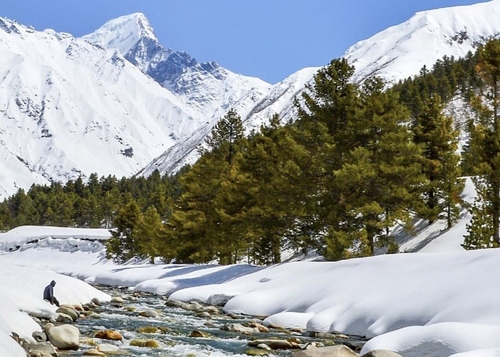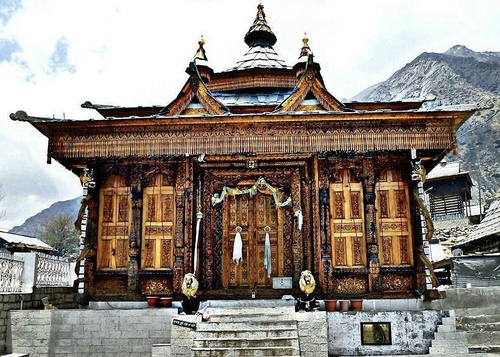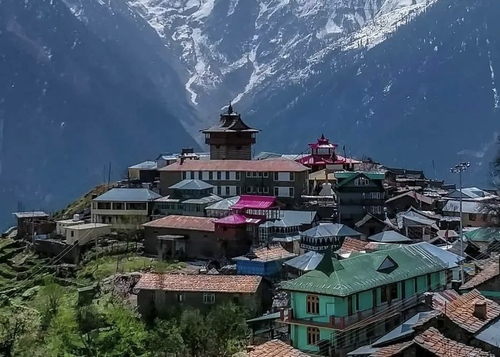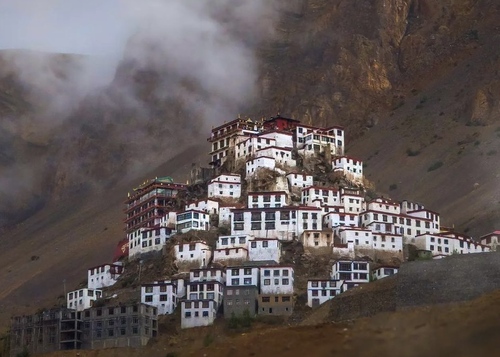Spiti Valley Summer Edition
![]() Himachal Pradesh
Himachal Pradesh
Located at 12,500 ft, Spiti Valley is a serene cold desert gateway between India and Tibet. Experience:
- Buddhist culture and monasteries (Key, Dhankar, Kungri, Tabo)
- Rugged villages and breathtaking landscapes
- Solitude and tranquility in nature
Tour Highlights
- Visit India's Last Village, Chitkul
- Lunch at 'Hindustan ka Aakhri Dhaba'
- Explore Komic, the World's Highest Motorable Village
- Send postcards from the Highest Post Office in the World
- Shop for souvenirs on Manali's famous Mall Road
Join Us
Embark on a photographic journey through Spiti's pristine beauty. Capture:
- Stunning high-altitude desert landscapes
- Ancient monasteries and villages
- Unique cultural experiences
Natural Wonders:
1. Breathtaking Himalayan landscapes
2. Scenic drives through Kinnaur and Spiti valleys
3. Visit to Chitkul, last village on Indo-Tibet border
4. Explore Nako Lake and its picturesque village
5. Witness stunning sunrises and sunsets
Cultural Experiences:
1. Visit iconic monasteries: Key, Dhankar, Kungri, Tabo
2. Explore ancient villages: Kibber, Komik, Langza, Hikkim
3. Interact with locals and learn about Tibetan culture
4. Attend a traditional Buddhist prayer ceremony
5. Discover local art and handicrafts
Adventure Activities:
1. Trek to Dhankar Lake or other nearby trails
2. River rafting in Spiti River
3. Camping under starry skies
4. Mountain biking through rugged terrain
5. Visit world's highest post office (Hikkim)
Offbeat Destinations:
1. Gue Village (mummy village)
2. Langza Village (Buddha statue)
3. Komik Village (highest village)
4. Hikkim Village (highest post office)
5. Kalpa Village ( breathtaking views)
Food and Stay:
1. Savor local cuisine: Tibetan, Himalayan, and Indian
2. Stay in cozy homestays, guesthouses, or camps
3. Enjoy bonfires and stargazing
Road Trip Essentials:
1. Distance: approximately 1,400 km
2. Duration: 7 days
3. Best time: June-October
4. Vehicle: SUV or sedan with good ground clearance
5. Permits: required for certain areas (check ahead)
Tips and Precautions:
1. Acclimatize to high altitude
2. Carry essentials: water, snacks, first-aid kit
3. Check weather forecast
4. Respect local culture and environment
5. Plan for contingencies (roadblocks, landslides)
Embark on this epic Spiti Road Trip for an unforgettable adventure!
Adventure Seekers:
1. Thrill-seekers
2. Trekking enthusiasts
3. Mountain bikers
4. River rafting enthusiasts
Nature Lovers:
1. Photography enthusiasts
2. Birdwatchers
3. Wildlife enthusiasts
4. Landscape admirers
Culture Enthusiasts:
1. History buffs
2. Architecture enthusiasts
3. Buddhist culture enthusiasts
4. Local art and handicrafts enthusiasts
Travel Enthusiasts:
1. Backpackers
2. Solo travelers
3. Couples
4. Families with older children (above 10 years)
Those Seeking Solitude:
1. Meditation and yoga practitioners
2. Writers and artists
3. Those seeking digital detox
4. Individuals looking for self-reflection
Age Groups:
1. Young adults (12-35 years)
2. Middle-aged individuals (36-60 years)
3. Senior citizens (above 60 years) with good health
Fitness Levels:
1. Moderate fitness (trekking, walking)
2. Good physical condition (for high-altitude travel)
Interests:
1. Exploration
2. Photography
3. Culture
4. Nature
5. Adventure
6. Spirituality
7. History
8. Architecture
If you identify with any of these categories, the Spiti Valley road trip is an unforgettable experience awaiting you!
Reporting and Departure
- Assembly Time: 9:00 PM
- Assembly Point:Majnu ka Tila
- Meet your Team Captain and fellow travelers
- Group Induction and Briefing Session
Overnight Journey to Shimla
- Depart from Delhi and embark on an exciting journey to Shimla
- Travel through the scenic Himalayan routes
- Enjoy the comfort of an AC Volvo/ Deluxe Bus/ Tempo Traveler
- Overnight journey to Shimla, the Queen of Hills
Essentials
- Carry comfortable clothing and footwear
- Bring snacks and water for the journey
- Charge your devices and carry power banks
- Be prepared for an adventurous journey!




















By Air:
Indira Gandhi International Airport (IGI) in Delhi is a feasible option for traveling to Spiti as it serves both domestic and international flights.
By Rail:
Another alternative is the New Delhi Railway Station, through which most trains arrive and depart from Delhi to all around India.
By Road:
Delhi is well connected by bus to major cities like Jaipur, Agra, Alwar, Dehradun, and even Kathmandu, among others.
• Smoking and drinking is not allowed in tempo traveller.
• There will be no tap water in winters in Homestays in Spiti Valley, so you’ll get Dry Toilets everywhere. You’ll get water only to freshen up and drinking.
• Misbehave and abusive attitude will not be tolerated at any cost. If anyone is found doing then his/her trip shall be terminated there itself.
• Travelers must take care of their luggage & belongings. We shall not be responsible for any damage or any missing items along the tour.
• Nobody is allowed to enter anybody's room without their permission.
• Sharing in Chandratal Camps will be allotted on TRIPLE/QUAD basis only. The sharing opted by you won't be applicable at Chandratal stay as it is a remote area with no network and village around and a smaller number of camps available there.
Spiti Valley is a cold desert mountain valley nestled in the midst of Himalayas. Surrounded by majestic mountains, it is located in the north-eastern region of Himachal Pradesh.
1) Chitkul: The final Indian village in the nation with the purest air. Literally, this little hamlet is a breath of fresh air.
2) Kalpa: One of the locations you just can't miss when on a journey to the Spiti valley is Kalpa, which has a spectacular view of the Kinner Kailash peaks, apple orchards, tranquillity, and the suicide point that makes your heart beat faster.
3) Khab: The Reo Purgyil forms the backdrop of this panorama that resembles a dream as the Spiti and Sutlej rivers merge to form a commune in the middle of Khab.
4) Nako: A charming village, Nako is the epitome of calm with the tranquil Nako Lake and Nako monastery.
5) Pin Valley: A haven for environment lovers, Pin Valley is renowned for its wildlife reserve, varied flora and fauna, and beautiful green woods.
6) Kaza: The commercial hub of Spiti, Kaza is the bridge that connects Spiti to its surrounding valleys and provides a view of the region's unique blend of ancient and modern traditions.
7) Langza: Known as the town of the Gods, Langza is well-known for its profusion of fossils. The 1000-year-old Buddha statue that watches over the community as its vigilant protector is the major draw.
8) Komic: The Spiti Valley is home to the highest settlement in the world. It is a small, isolated hamlet with lots of peace and a sparse population.
9) Kibber: A little settlement that is home to humans yet where you can still see the endangered snow leopard. It serves as a lovely lookout that provides a breathtaking view of the valley.
10) The Monasteries: Spiti is home to many charming villages, but what makes it stand out are the ancient monasteries that house thangka paintings, murals, and Buddha relics. In the Spiti Valley, some of the most well-known monasteries are:
Monastery Tabo, Kungri Monastery, Gue Monastery, Nako Monastery, Sakya Tangyud Monastery, Dhankar Monastery.
Depending on the kind of landscapes you like. The best time to visit Spiti Valley would be between the months of December to April if you love snow and want to take in all the beauty of this winter wonderland.The best season to visit Spiti Valley is from June to November if you don't mind the cold and just want to relax in the sun.The Spiti valley experiences little change from the monsoon's arrival, and the climate is very pleasant. The pristine Chandratal lake, which is inaccessible in the winter because it is frozen, is also accessible during these months.
if you want to enjoy the beauty of the place, you will need a minimum of 7 days. Anything less would be an injustice to Spiti Valley’s beauty. You can spend more time in Spiti Valley if you have extra days.
Yes, Spiti valley is completely safe to travel, just make sure you visit in the right months i.e during the months of May to September. The roads are a bit dangerous and are one of the toughest adventure roads to drive on. There are a lot of sections of the road where there’s gravel, making it difficult to drive, but it is always recommended to take an experienced driver with you. Rest, the place is very safe and the locals are very warm and welcoming to tourists.
The Spiti Valley is renowned for its scenic landscapes and rich cultural history. One of Spiti's most well-known sights is Tabo Monastery. Spiti's monasteries are well-known for their magnificent murals, historic temples, and numerous stupas.
Spiti valley preparation involves thoughtful planning ahead of time rather than simply packing a bag and going. The northeastern region of India is covered in snow-capped mountains, thus carrying the appropriate wool gear is necessary for high-altitude climbs. You might need to wear lightweight layers (woollen and cotton clothing) during the day and add thermals or thick coats at night. Depending on the season you choose to visit Spiti, you may need to bring regular jeans, thick pants, a pair of socks, a cap, a scarf, hiking boots, sunglasses, full-sleeved shirts, sweatshirts, gloves, mufflers, and fleece jackets.Torch, medications, sunscreen, lip balm, sanitizers, hygiene, camera equipment, chargers, and power banks are additional essentials. As you go, mobile connectivity will probably be poor.
Some of us prefer the pleasure of open riding on hilly roads and breathing in the crisp air, even though riding a bike through the valley is a wonderful rush. But make sure the rider is in charge of a robust bike that can handle the rugged terrain. Manali is the finest location to rent a bike because there are several tour companies and maintenance shops there that offer well-kept, strong bikes for rent.
Weather in Spiti is very pleasant from April-October, with the May-June temperatures around 15-20 degrees amke it a good time to visit Spiti. In winters the temperature falls as low as minus 20 degrees celcius.
The Trans Himalayas surround the whole Spiti region, making it challenging to install ATMs. Even though there are ATMs, getting cash and replenishing the ATMs with cash might be difficult, especially during the winter when roads from the Manali side are closed. Having said that, it should be noted that the State Bank of India has an ATM in Kaza, the district centre for the Spiti region.
Located at well over 3,000 m altitude high up in the mountains, Spiti welcomes travellers to its postcard-perfect hamlets, surreal landscapes, plentiful trekking trails, ancient monasteries and scenic lakes.
The oxygen is indeed very thin in Spiti Valley but if you remember to keep yourself hydrated with small sips of water, it should not bother you.
Kaza, also spelled Kaze, Karze, Karzey, is a town and the subdivisional headquarters of the remote Spiti Valley in the western Himalayas in the Lahaul and Spiti district of the northern Indian state of Himachal Pradesh.
15000ft high, Kunzum Pass is the highest motorable point on the Manali to Spiti to Shimla or reverse route.
Spiti valley trekking is 55 km long, and it will take you at least 5 days to cover the entirety of it. As far as difficulty level is concerned, the trail is easy to moderate and can be done easily with a little bit of training.
An altitude as high as the Spiti Valley ensures almost zero light and sound pollution for an unreal viewing experience. Apart from simply stargazing one can also spot the Milky Way and if you're lucky, a couple of shooting stars too.
Our rooms are on double, triple, and quad sharing basis. (Offers are subject to availability.)
YES, If you want us to design a customized itinerary for you and your family/friends, reach out to us at info@travelmite.com or Call us at 8010000205.

Company Name: company name
Read More